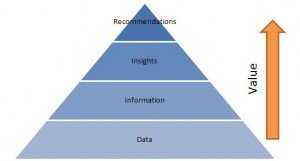We’re not being anal-retentive…analytics matter.
Speakers:
Eric Peterson – Web Analytics Demystified
Aaron Gray – Greater Returns
Moderator:
Hallie Janssen
LiveBlogger:
Kim Toomey of Anvil Media, a Search Engine Marketing (SEM) Agency
Session Details:
Eric Peterson kicked off this session with a top-down approach to web analytics for your organization.
Web analytics fails marketers for a number of reasons:
- It’s a complex technology. Many enterprise level analytics platforms are not inherently user friendly and require complex training to make them work for you.
- We’re afraid of numbers. And math. But also the terminology used can be confusing. We have to sort out the difference between visitors and daily visits vs. monthly visits and unique visitors and clicks! Oh my.
- There are always some unknowns to analytics. Some things we still cannot account for. The analytics industry as a whole is working to remedy this, but that’s going to involve things like math and more complex terminology.
- We don’t have enough time/energy/enthusiasm.
So how do we solve these problems you ask? Because web analytics IS IMPORTANT! (Can I get a Hallelujah?!)
The answer is to take a top down approach, meaning…
- Organize your output – piles of excel spreadsheets are useless. Make the data relevant and understandable for you and your team/boss.
- Evaluate your tools. Not any one analytics tool will do everything you want it to. It won’t. Figure out what you need to find out from your data and then get the right tools for the job.
- Balance your investments. Peterson recommends taking a 50/50 approach to tools and people. 50% of your budget on tools and 50% on people to manage those tools. *If you’re using a free solution, pretend it cost you money. Peterson guarantees that if you slap Google analytics on your site and don’t invest any other resources to manage/report, then you won’t have a successful analytics strategy.
Your analytics reporting should ultimately be providing you with insights not data. Please refer to my own rendition of what I will call “Peterson’s hierarchy of analytics value”
 And in recap – Google analytics is free/awesome/wonderful/FREE!
And in recap – Google analytics is free/awesome/wonderful/FREE!
But, it doesn’t do everything, so again – find all the tools you need based on your goals and use them. When done right, analytics results can be awesome.
Our second speaker, Aaron Gray took a Bottoms up approach to Analytics.
The tools and technology that you use collect behavior data ultimately. These tools really need to be used to optimize your business and understand your customers (again, going back to the pinnacle of web analytics strategy – that data should ultimately provide business recommendations).
You can’t manage what you don’t measure. And you can’t get better as a business without managing your efforts. So you better be measuring. Your business and website goals should drive your analytics strategy. This is the only way you’ll be able to improve your value contribution to the overall organization. And think of not only improving the value you are adding but even proving your value, and the value of the activities you are managing.
A quick vendor cheat sheet for you (just a few – most of these guys are pretty well known)
- CoreMetrics – great for retail
- Unica – newer player gaining marketing headway
- Woopra – started out as a blog monitoring tool, but has evolved to much more
- OneStat
- Clicky
- VisiStat
There are four basic buckets of things to be looking at within your analytics strategy:
- Traffic & Audience Analytics
- Voice of Customer
- Infrastructure
- Community Measurement
Make sure you are connecting conversions to marketing. Traffic is pretty useless – focus on value generation.
There are two ways to really use your analytics data, look back or look forward.
If you’re going to look back, use your data to understand what works & what didn’t and then optimize your existing marketing efforts from those learnings.
If you’re going to look forward and do some predictive modeling, use your analytics data to determine the response and spend required to meet your goals. If you know existing conversion rates, you can determine how many more visitors you need to increase your total conversions/sales/leads. Then you just need to figure out the best way to grow your traffic.
Here is a link for the workback waterfall demonstration that Aaron did on predictive modeling: https://bit.ly/DeckerBullseye
The key takeaway from Aaron’s presentation was to focus on your goals and ensure that your analytics is reporting and providing insights on your progress towards achieving those objectives.
Announcement type posts of this type are made by the board collectively, and you can see who the current board members are here.
